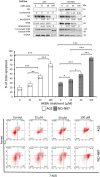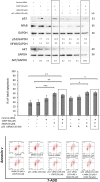Boswellic acid sensitizes gastric cancer cells to Cisplatin-induced apoptosis via p53-mediated pathway
- PMID: 32867831
- PMCID: PMC7460741
- DOI: 10.1186/s40360-020-00442-1
Boswellic acid sensitizes gastric cancer cells to Cisplatin-induced apoptosis via p53-mediated pathway
Abstract
Background: Cisplatin (CDDP) is an effective anticancer drug for Gastric cancer (GC) that induces apoptosis by altering pro- (p53) and anti-apoptotic (Akt and NFkB) proteins; however, chemoresistance remains a big challenge. Additional compounds with promising anticancer effects such as AKBA (Acetyl-keto-beta boswellic acid) may overcome the resistance. However, its role in CDDP-induced apoptosis in GC has not been studied. This study aimed to examine the effectiveness of AKBA on p53-mediated, CDDP-induced apoptosis in GC cells. AGS and NCI-N87 cells were treated with different concentrations (0, 25, 50, 100 μM) of CDDP and/or AKBA.
Methods: P53, Akt and NFkB proteins and apoptosis were assessed by Western blot and flow cytometry. The role of p53 was determined by inhibiting its function via the siRNA approach.
Results: The results revealed that CDDP and AKBA significantly increased p53 content in both cells, while Akt and NFkB were significantly decreased. Both compounds significantly induced apoptosis in a dose-dependent manner. AKBA sensitized GC cells to CDDP-induced apoptosis by altering the protein expression. P53 downregulation affected Akt and NFkB proteins with a slight increase in apoptosis induction in the combination treated groups.
Conclusions: Altogether, our findings suggest that AKBA enhances GC cell sensitivity to CDDP-induced apoptosis via the p53 pathway.
Keywords: AKBA; Apoptosis and gastric cancer; CDDP; P53.
Conflict of interest statement
The authors declare no competing Interests.
Figures




References
-
- WHO. Cancer. Who.int. http://www.who.int/mediacentre/factsheets/fs297/en/. Published 2017.
-
- Abbas A, Aster J, Kumar V, Perkins J. Robbins Basic Pathology. 9th ed: Elsevier Saunders; 2013. p. 570–3.
-
- Clark M, Finkel R. Lippincott's Illustrated Reviews: Pharmacology. 5. Baltimore: Lippincott Williams & Wilkins; 2012. pp. 507–508.
Publication types
MeSH terms
Substances
Grants and funding
LinkOut - more resources
Full Text Sources
Medical
Research Materials
Miscellaneous

